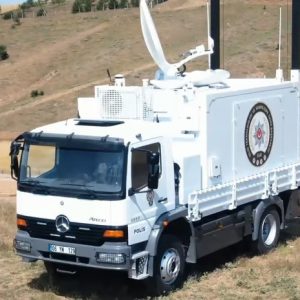In the dynamic landscape of defense and aerospace, the impact of game-changing technologies is reshaping the future of warfare. advancements in technology play a pivotal role in shaping the strategies and capabilities of nations. As we navigate the complex terrain of modern warfare, it becomes imperative to analyze the profound impact of new and game-changing technologies on the future of military operations. As specialists in the field, we delve into the profound implications these advancements hold for military strategies, tactics, and global security.

The Impact of Game-Changing Technologies on the Future Landscape of Warfare
Quantum Computing: Unleashing Unprecedented Processing Power
The emergence of Quantum Computing stands as a monumental leap forward. This groundbreaking technology is poised to unleash unprecedented processing power, reshaping the way we approach complex computations and unlocking new frontiers in research, simulation, and encryption. One of the most revolutionary advancements is the integration of quantum computing in military operations. Quantum computers, with their ability to process vast amounts of data at unparalleled speeds, are poised to transform decision-making processes. From complex simulations to decrypting enemy communications, the applications are limitless. The era of quantum supremacy brings forth a paradigm shift, enabling the military to stay steps ahead in strategic planning.
Aerospace simulations demand immense computational power for accurate modeling of aerodynamics, structural integrity, and fluid dynamics. Quantum Computing’s ability to process complex simulations at an unprecedented speed holds immense promise for accelerating aerospace research. From optimizing aircraft designs to predicting atmospheric conditions, quantum-powered simulations open new horizons for innovation in the aerospace industry.
In the pursuit of lightweight and durable materials, Quantum Computing becomes a catalyst for materials discovery. Its ability to analyze and predict the properties of materials at the quantum level expedites the development of advanced alloys and composites, contributing to the creation of aerospace materials with superior strength and performance.
As quantum computers evolve, so does the concern about their potential to break traditional encryption methods. Quantum-resistant cryptography, a field gaining prominence in defense strategies, utilizes the unique properties of quantum mechanics to create encryption algorithms resilient to quantum attacks. Quantum Computing becomes not only a tool for processing power but also a driving force in shaping the future of secure communications in defense.
The ability of Quantum Computing to handle vast datasets and complex algorithms in real-time enhances strategic decision-making in defense. From analyzing geopolitical trends to optimizing resource allocation, quantum-enhanced intelligence provides a significant advantage in navigating the intricate landscape of global security.
In conclusion, Quantum Computing stands as a beacon of technological advancement in the defense and aerospace industry. Its potential to revolutionize processing power, accelerate simulations, enhance security, and redefine strategic decision-making positions it at the forefront of innovation. As we navigate the quantum frontier, continuous collaboration, research, and advancements in quantum hardware will shape the trajectory of Quantum Computing, unlocking unprecedented possibilities for the future of defense and aerospace.
Artificial Intelligence and Autonomous Systems: A Force Multiplier
One of the most transformative developments in recent years is the integration of Artificial Intelligence (AI) in military applications. AI not only enhances the efficiency of decision-making processes but also empowers autonomous systems. From unmanned aerial vehicles (UAVs) to ground-based robots, AI-driven technologies are reshaping the battlefield, providing strategic advantages to those who harness their potential.
The utilization of AI in war simulations and strategic planning allows military commanders to simulate various scenarios, refining their tactics and responses. This not only optimizes resource allocation but also minimizes risks associated with untested strategies. As AI continues to evolve, its role in military operations is set to become even more central, fundamentally altering the dynamics of warfare.
The integration of artificial intelligence (AI) and autonomous systems amplifies the efficiency and precision of military endeavors. AI-driven algorithms analyze massive datasets, offering predictive insights and enhancing situational awareness. Autonomous drones and vehicles play a pivotal role in reconnaissance, surveillance, and even combat, reducing human exposure to potential threats. The battlefield of the future relies on these technologies to outmaneuver adversaries swiftly and decisively.
Cyber Warfare: The Silent Battlefield
In the era of digital advancements, cyber warfare has emerged as a pivotal domain shaping the outcomes of conflicts. The capacity to disrupt adversary networks, manipulate information, and protect vital infrastructure has become essential. Cybersecurity measures are not merely optional but imperative, as nations endeavor to strengthen their defenses against intricate cyber threats. The convergence of technology and warfare has expanded beyond conventional battlefields into the complex realm of cyberspace.
In a world dominated by information technology, the concept of warfare has transcended physical boundaries and entered the domain of cyberspace. Cyber warfare stands out as a crucial element in contemporary conflicts, where nations vie for superiority through technological expertise. The capability to disrupt enemy communication networks, compromise critical infrastructure, and execute targeted cyber-attacks has become a defining factor in geopolitical struggles.
Advanced malware, ransomware, and sophisticated persistent threats (APTs) serve as instruments on the digital battlefield, posing substantial challenges to conventional defense mechanisms. With nations making substantial investments in cyber capabilities, the future of warfare is poised to witness an intensification in cyber conflicts, as countries compete for dominance in the virtual domain.
5G Technology: Enhancing Connectivity and Coordination
The advent of 5G technology stands as a groundbreaking paradigm shift. We, as industry specialists, recognize the profound impact of this transformative technology on enhancing connectivity and coordination in modern warfare. In this comprehensive exploration, we delve into the intricate details of 5G’s role in reshaping military strategies and capabilities. The implementation of 5G technology in military communication networks is a game-changer. The ultra-fast, low-latency connectivity facilitates real-time data transfer, enabling seamless coordination among troops and enhanced communication between command centers. In the modern theater of warfare, where information is power, 5G becomes a force multiplier, ensuring rapid and reliable communication that is crucial for strategic success.
At the core of 5G’s transformative prowess lies its ability to establish a robust and ultra-fast communication infrastructure. With unprecedented data transfer speeds and low latency, 5G networks become the backbone of military operations, ensuring seamless connectivity in the most demanding scenarios. The enhanced reliability and responsiveness of 5G empower military forces to execute coordinated actions with unparalleled efficiency. One of the standout features of 5G is its capability to facilitate real-time data exchange. This is a game-changer in military operations, providing commanders with instantaneous access to critical information. The ability to make informed decisions in the heat of the moment is crucial, and 5G technology positions armed forces at the forefront of tactical superiority.
5G’s influence extends beyond speed; it fosters a new era of interoperability among diverse military systems. Integrated communication systems, powered by 5G, enable seamless coordination between ground forces, naval fleets, and aerial units. This interconnectedness enhances the synergy of military components, creating a unified front capable of responding swiftly to dynamic threats. The precision afforded by 5G technology is not confined to communication alone. The implementation of 5G in command-and-control systems elevates the efficiency of decision-making processes. Military commanders can now orchestrate complex maneuvers with precision, optimizing resource allocation and response times to ensure mission success.
Blockchain: Securing Military Operations
Blockchain technology has emerged as a revolutionary force, transcending its origins in the realm of cryptocurrencies. Its decentralized nature, characterized by a distributed ledger, is now finding remarkable applications in the defense and aerospace industry. At the core of blockchain’s influence on the military is its decentralized architecture. In traditional systems, centralized databases pose a significant risk of tampering and unauthorized access. Blockchain, on the other hand, operates on a network of nodes, making it resistant to manipulation. This inherent decentralization ensures the integrity of sensitive military data, preventing malicious actors from compromising vital information. In this context, we can consider the use of blockchain in defense and aerospace under the following main headings.
Efficient logistics are paramount in military operations, and blockchain is proving to be a game-changer in this arena. The technology’s transparent and immutable ledger facilitates real-time tracking of supplies, equipment, and personnel movements. From the manufacturing floor to the front lines, every step in the supply chain is recorded securely, reducing the likelihood of errors and enhancing overall operational efficiency.
In the complex landscape of defense, seamless intelligence sharing is critical. Blockchain provides a secure platform for the exchange of sensitive information among various military entities. The decentralized nature of the technology ensures that intelligence data remains tamper-proof, fostering trust among collaborators. This trust is paramount in joint military endeavors, where accurate and timely information can make the difference between success and failure.
As cyber threats become increasingly sophisticated, safeguarding military networks is of paramount importance. Blockchain’s cryptographic principles provide a robust defense against cyber-attacks. The decentralized and encrypted nature of the technology makes it inherently resilient to hacking attempts, ensuring the confidentiality and integrity of sensitive military data.
Directed Energy Weapons: Precision and Versatility
The advent of directed energy weapons (DEWs) signifies a paradigm shift towards more precise and versatile capabilities on the battlefield. Comprising advanced technologies such as lasers and microwave systems, DEWs are reshaping the dynamics of warfare by offering rapid and accurate target engagement. The multifaceted realm of DEWs, exploring their implications, advantages, and the pivotal role they play in modern defense strategies.
DEWs stand out for their unparalleled precision and versatility. Unlike traditional munitions, DEWs harness directed energy in the form of concentrated beams, enabling pinpoint accuracy in target engagement. This precision not only enhances the effectiveness of military operations but also significantly reduces collateral damage, a crucial consideration in contemporary warfare scenarios.
One of the key components of DEWs is laser technology, which has emerged as a game-changer in modern warfare. Laser-based DEWs offer the advantage of speed-of-light engagement, ensuring rapid response times. This instantaneous targeting capability provides military forces with a decisive edge, allowing them to neutralize threats swiftly and efficiently.
In addition to lasers, microwave systems constitute another facet of DEWs, introducing a silent yet lethal dimension to military capabilities. Microwave-based DEWs can disrupt electronic systems, disable enemy communications, and even incapacitate unmanned aerial vehicles (UAVs). This versatility makes them a formidable asset in electronic warfare, further expanding the scope of strategic options available to military planners.
As technology continues to advance, the integration of DEWs into modern defense strategies becomes not only advantageous but imperative for maintaining military superiority. The adaptability of DEWs to various operational environments, coupled with their capacity for rapid response, positions them as indispensable assets for ensuring national security.
Hypersonic Missiles: Unmatched Speed and Evasion
Hypersonic missiles stand out as a transformative force, redefining the speed and reach of conventional arsenals. Surpassing velocities of Mach 5, these cutting-edge missiles present a formidable challenge to traditional defense systems, providing a substantial advantage to the possessing military. Hypersonic technology, exploring its impact on global defense dynamics and the imperative for nations to adapt swiftly by investing in advanced countermeasures.
Traditional defense systems, designed to intercept slower projectiles, face a monumental challenge in countering hypersonic missiles. The sheer speed of these missiles renders traditional anti-missile technologies ineffective, compelling nations to explore innovative defense mechanisms capable of keeping pace with the hypersonic threat. The urgency to develop and deploy advanced countermeasures becomes paramount in safeguarding national security.
The advent of hypersonic technology is reshaping the dynamics of modern warfare by introducing a paradigm shift in offensive capabilities. The ability to strike targets with unprecedented speed and evasion capabilities grants a strategic advantage to the possessing military. As a result, nations worldwide are compelled to adapt their military doctrines and invest substantially in research and development to stay ahead in this rapidly evolving arms race.
The integration of hypersonic missiles into military arsenals requires a reevaluation of existing doctrines. Emphasizing speed, precision, and strategic flexibility becomes paramount as nations incorporate hypersonic capabilities into their military strategies. Joint operations and collaborative defense initiatives gain significance in countering the hypersonic threat effectively.
Biotechnology: The Future Soldier
Advancements in biotechnology stands at the forefront, reshaping the very fabric of armed forces and ushering in an era of enhanced and resilient soldiers. Profound advancements in biotechnology, exploring the convergence of genetic engineering, augmented reality, and wearable technologies that together give rise to a new breed of warriors with unprecedented cognitive abilities and adaptive physiology.
Genetic engineering has emerged as a cornerstone in the evolution of military capabilities, allowing for the precise modification of an individual’s DNA to enhance physical attributes, cognitive functions, and overall resilience. The future soldier, forged through genetic interventions, possesses a tailored genetic makeup that optimizes performance in diverse operational environments.
The integration of Augmented Reality (AR) in military operations transcends conventional boundaries, providing soldiers with real-time data overlays and enhanced situational awareness. AR-equipped helmets and visors empower soldiers to make split-second decisions by superimposing critical information onto their field of view, thereby optimizing cognitive abilities in high-pressure scenarios.
Wearable technologies play a pivotal role in creating adaptive soldiers capable of seamlessly interacting with their environment. Smart fabrics, embedded sensors, and biomechanical enhancements enhance physical capabilities, allowing soldiers to operate more efficiently and endure the rigors of extended missions. This synergy between biology and technology redefines the limits of human performance on the battlefield.
The advancements in biotechnology herald a new era in the evolution of military forces. The synthesis of genetic engineering, augmented reality, wearable technologies, and biometric data integration crafts a formidable soldier, reshaping the very nature of warfare. As we navigate the ethical considerations and strategic implications, it is evident that the convergence of biology and technology will continue to define the future of military capabilities, ensuring that armed forces remain at the forefront of innovation and adaptability.
Space War: The New Frontier in Warfare
As nations expand their presence beyond Earth’s atmosphere, **space warfare** emerges landscape of military strategy undergoes a paradigm shift with the emergence of space warfare. Satellites, serving as linchpins for communication, surveillance, and reconnaissance, now find themselves vulnerable to potential attacks from rival nations. The development of anti-satellite (ASAT) weapons introduces a significant threat, capable of disrupting the delicate equilibrium of power in orbit.
Satellites, once considered invulnerable assets in the vastness of space, now face unprecedented challenges. The reliance on these orbiting entities for critical functions such as communication, weather monitoring, and global positioning makes them prime targets in the evolving landscape of geopolitical competition. The realization that these vital instruments can be rendered ineffective through intentional attacks underscores the need for a comprehensive understanding of space warfare dynamics.
The development of anti-satellite (ASAT) weapons marks a pivotal juncture in the evolution of military capabilities. These specialized weapons are designed to target and neutralize satellites, posing a multifaceted threat to national security. ASAT capabilities range from kinetic methods, such as direct impact or collision, to non-kinetic methods like electronic jamming and cyber-attacks, reflecting the complexity of space warfare strategies.
As nations navigate the complexities of a world where space becomes an arena for strategic competition, the concept of militarization of space takes center stage. The ability to safeguard and assert dominance in this cosmic domain becomes not only a strategic imperative but a crucial factor in shaping the geopolitical landscape on Earth. The repercussions of space warfare extend far beyond the boundaries of our planet, influencing alliances, power dynamics, and global security architectures.
In response to the growing challenges posed by space warfare, nations are investing heavily in the development of space-based defense systems. These sophisticated systems encompass a range of technologies, including satellite defense platforms, early warning systems, and countermeasure capabilities. The goal is to create a robust defense infrastructure capable of thwarting potential attacks on vital satellites and ensuring uninterrupted functionality of space-based assets.
The evolution of space warfare introduces a new frontier in military strategy, where the safeguarding of dominance in the cosmos becomes a critical imperative. The vulnerabilities of satellites, the development of ASAT weapons, and the militarization of space underscore the need for nations to adapt and innovate in the face of evolving security challenges. As the complexities of space warfare continue to unfold, strategic foresight, technological advancements, and international collaboration will play pivotal roles in shaping the future of military operations beyond Earth’s atmosphere.
Conclusion: Game-Changing Technologies of the Future
In summary, the undeniable influence of groundbreaking technologies on the future of warfare is evident. Whether it’s the advent of quantum computing or the development of hypersonic missiles, each technological stride alters the dynamics of military strategy and global security. As specialists in the defense and aerospace industry, our grasp of these transformative technologies equips us to navigate the forthcoming battlefield with precision and foresight. The trajectory of warfare’s evolution is intricately intertwined with technological progress, demanding continuous adaptation and innovation to stay ahead in this dynamic landscape.
Within the swiftly evolving theater of warfare, the indisputable impact of novel and game-changing technologies is reshaping the landscape. The amalgamation of artificial intelligence, cyber capabilities, advanced weaponry, space dominance, and biotechnology is not only transforming military strategies but also influencing capabilities on a global scale. Nations adept at leveraging these advancements are poised to hold a decisive advantage in the unpredictable arena of modern conflict.
As the defense and aerospace industries relentlessly push the boundaries of innovation, the future battlefield will be characterized by a dynamic interplay of technologies, each competing for supremacy. Adapting to these changes is not merely an option; it is a strategic imperative for nations striving to safeguard their interests and maintain a competitive edge in the complex geopolitical arena. The dawn of a new era in warfare is on the horizon, and those who master the intricacies of cutting-edge technologies will undoubtedly shape the destiny of nations on the global stage.










